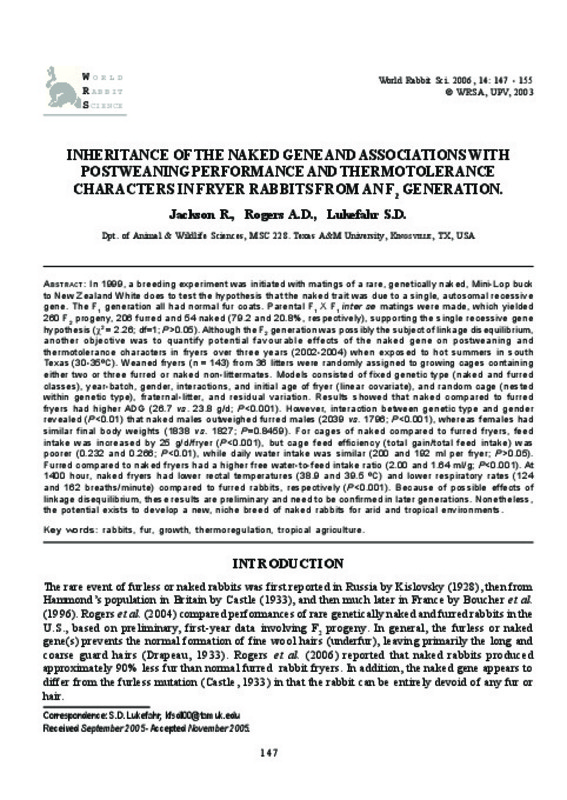JavaScript is disabled for your browser. Some features of this site may not work without it.
Buscar en RiuNet
Listar
Mi cuenta
Estadísticas
Ayuda RiuNet
Admin. UPV
Inheritance of the naked gene and associations with postweaning performance and thermotolerance characters in fryer rabbits from an F2 generation
Mostrar el registro sencillo del ítem
Ficheros en el ítem
| dc.contributor.author | Jackson, R.
|
|
| dc.contributor.author | Rogers, A.D.
|
|
| dc.contributor.author | Lukefahr, S.D.
|
|
| dc.date.accessioned | 2011-02-09T11:05:35Z | |
| dc.date.available | 2011-02-09T11:05:35Z | |
| dc.date.issued | 2006 | |
| dc.identifier.issn | 1257-5011 | |
| dc.identifier.uri | http://hdl.handle.net/10251/9587 | |
| dc.description.abstract | [EN] In 1999, a breeding experiment was initiated with matings of a rare, genetically naked, Mini-Lop buck to New Zealand White does to test the hypothesis that the naked trait was due to a single, autosomal recessive gene. The F1 generation all had normal fur coats. Parental F1 X F1 inter se matings were made, which yielded 260 F2 progeny, 206 furred and 54 naked (79.2 and 20.8%, respectively), supporting the single recessive gene hypothesis (c2=2.26; df=1; P>0.05). Although the F2 generation was possibly the subject of linkage disequilibrium, another objective was to quantify potential favourable effects of the naked gene on postweaning and thermotolerance characters in fryers over three years (2002-2004) when exposed to hot summers in south Texas (30-35ºC). Weaned fryers (n=143) from 36 litters were randomly assigned to growing cages containing either two or three furred or naked non-littermates. Models consisted of fixed genetic type (naked and furred classes), year-batch, gender, interactions, and initial age of fryer (linear covariate), and random cage (nested within genetic type), fraternal-litter, and residual variation. Results showed that naked compared to furred fryers had higher ADG (26.7 vs. 23.8 g/d; P<0.001). However, interaction between genetic type and gender revealed (P<0.01) that naked males outweighed furred males (2039 vs. 1796; P<0.001), whereas females had similar final body weights (1838 vs. 1827; P=0.8459). For cages of naked compared to furred fryers, feed intake was increased by 25 g/d/fryer (P<0.001), but cage feed efficiency (total gain/total feed intake) was poorer (0.232 and 0.266; P<0.01), while daily water intake was similar (200 and 192 ml per fryer; P>0.05). Furred compared to naked fryers had a higher free water-to-feed intake ratio (2.00 and 1.64 ml/g; P<0.001). At 1400 hour, naked fryers had lower rectal temperatures (38.9 and 39.5ºC) and lower respiratory rates (124 and 162 breaths/minute) compared to furred rabbits, respectively (P<0.001). Because of possible effects of linkage disequilibrium, these results are preliminary and need to be confirmed in later generations. Nonetheless, the potential exists to develop a new, niche breed of naked rabbits for arid and tropical environments. | es_ES |
| dc.language | Inglés | es_ES |
| dc.publisher | World Rabbit Science. ICTA. UPV | es_ES |
| dc.relation.ispartof | World Rabbit Science | |
| dc.rights | Reserva de todos los derechos | es_ES |
| dc.subject | Rabbits | es_ES |
| dc.subject | Fur | es_ES |
| dc.subject | Growth | es_ES |
| dc.subject | Thermoregulation | es_ES |
| dc.subject | Tropical agriculture | es_ES |
| dc.title | Inheritance of the naked gene and associations with postweaning performance and thermotolerance characters in fryer rabbits from an F2 generation | es_ES |
| dc.type | Artículo | es_ES |
| dc.date.updated | 2011-02-09T10:44:33Z | |
| dc.identifier.doi | 10.4995/wrs.2006.559 | es_ES |
| dc.rights.accessRights | Abierto | es_ES |
| dc.description.bibliographicCitation | Jackson, R.; Rogers, A.; Lukefahr, S. (2006). Inheritance of the naked gene and associations with postweaning performance and thermotolerance characters in fryer rabbits from an F2 generation. World Rabbit Science. 14(3). https://doi.org/10.4995/wrs.2006.559 | es_ES |
| dc.description.accrualMethod | SWORD | es_ES |
| dc.relation.publisherversion | https://doi.org/10.4995/wrs.2006.559 | es_ES |
| dc.description.volume | 14 | |
| dc.description.issue | 3 | |
| dc.identifier.eissn | 1989-8886 | es_ES |








